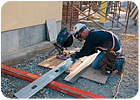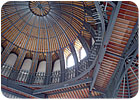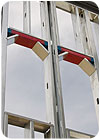
Founded in 1910 by Greek immigrant families in Indianapolis, Holy Trinity Greek Orthodox Church has been on a continuous journey of growth and change ever since. In November, the parish will make the third move in its history-this time, to the rapidly growing Indianapolis suburb of Carmel, Ind., and a spectacular new church that is already drawing curious glances from passersby.
In 1998, Holy Trinity parish membership had reached a level where expansion of the church building was needed; however, there was no additional room for growth at Holy Trinity’s central Indianapolis location. So, the parish bought 20 acres of land in Carmel, just northwest of Indianapolis, and hired San Francisco architectural firm CJK Design Group to design a new church. In addition to accommodating the growing congregation, the parish wanted the new church to exemplify the architectural style of Byzantine-style Orthodox churches in Europe and the Middle East-such as the sixth-century Cathedral of the Divine Wisdom (Aghia Sophia) in Constantinople. A world leader in the design of new construction Orthodox Christian churches, with classic European influence, CJK Design Group was selected for its expertise.

THE ARCHITECT
Raised in the Greek Orthodox Church, CJK Design Group Principal Christ J. Kamages, AIA, (“Christ” is pronounced “Kris”) has long been inspired by the breathtaking designs of ancient Byzantine cathedrals. These designs are characterized by beautiful expansive domes, arches and vaulted ceilings. The exquisite interior features of these churches include the traditional Greek Orthodox icon of Christ Pantocrator displayed at the center of the dome. Establishing CJK Design Group in 1984, Kamages consistently strives to mold this classic design inspiration with the design needs of modern-day Orthodox parishes. CJK Design Group now designs Orthodox Christian churches exclusively, completing more than 120 of them thus far. The grandeur of these churches’ designs often makes them showpieces in their communities.“Byzantine-era Orthodox churches were designed to have a very striking appearance, a representation of what God’s house might look like, so there’s both a technical and poetic side to them,” Kamages says.
The design of the Holy Trinity Greek Orthodox Church, which Kamages has named “the Triad,” is now registered at the Library of Congress, making it a true original.
“The church, in the end, will be a real national landmark because it’s a prototype,” Kamages says. “It’s the first of its kind for us, and we believe it’s going to be a real showpiece.”

THE MATERIAL
One of the recurring components in CJK Design Group’s Orthodox Christian churches is the use of steel framing. Aside from its obvious durability, steel offers the precision and complexities needed to accomplish more challenging design features, such as arches and vaults. Since steel is a non-combustible material, it also meets the requirements of non-residential construction permits.“We needed a non-combustible assembly to meet with the Type 2B construction requirements, and it was important for us to have the kind of precision that you wouldn’t get from wood framing,” says Patrick Whelan, associate and project director for CJK Design Group. “The precision and complexities of these steel products allow us to literally create heaven on earth, that special sacred space, in a church design.”
The new Holy Trinity Greek Orthodox Church is a steel structure with cold-formed steel framing infill and a brick and lath plaster exterior. CJK Design Group specified ClarkWestern UltraSTEEL Framing and for the exterior walls used the company’s structural studs and the RedHeader RO Rough Opening System.
THE PROJECT BEGINS
Holy Trinity Parish hired Indianapolis general contractor Shiel Sexton Co. Inc., to build the church, and the company began site preparation in September 2006. Construction of the 12,000 square-foot church began in August 2007 with the placement of the foundation. At the same time, steel fabrication contractor Indiana Steel Fabricators, of Indianapolis, began building a steel skeleton for the church’s enormous, ornate dome. Because of the dome’s immense size and weight, Kamages and Shiel Sexton devised a plan to completely build the dome on the ground as the atrium of the church went up and then lift it into place with three cranes. This reduced the need for scaffolding, since the dome would be situated 40 feet above ground level. Weighing 50 tons and measuring 52 feet in diameter, the dome is one of the largest Orthodox domes in the Western Hemisphere.
Shiel Sexton hired Indianapolis framing and drywall contractor Circle B Construction Co., who began work in October 2007. A crew of 10 framed the dome’s vaults, arches and windows in steel. Though structural stud and UltraSTEEL framing was used throughout most of the structure, the Red Header RO product was used on the dome’s windows and other non load-bearing areas. This innovative, all-in-one rough opening solution is easy to install and reduces the amount of materials and steel required for the job.
By November, the dome skeleton was finished and ready to be roofed. Minneapolis contractor M.G. McGrath Architectural Sheet Metal installed a custom aluminum standing-seam roof, with a shiny, gold-metallic baked-on finish to provide everlasting luster. The ornate, eye-catching dome drew much attention from curious Carmel neighbors last fall.
“They knew that a church was going up there, and, after seeing the dome, they were asking if the church was going to be shaped like an igloo or a UFO,” Kamages says.

RAISING THE DOME
Fortunately, it wasn’t long before the community speculations disappeared. The Holy Trinity Parish held a ceremony in late December 2007, at which the parish’s priest, the Rev. Anastasios Gounaris, blessed the gold-leafed, “Justinian”-style cross that was affixed to the peak of the dome. The next day, Shiel Sexton proceeded with the raising of the dome, creating temporary dome bracing, lift areas and a lift rigging, so the three cranes could hoist the dome on top of the church’s six steel columns. Once lifted, the dome was turned and positioned 40 feet above the ground. Characteristic of an Orthodox domed-church, the new Holy Trinity Greek Orthodox Church features a series of 20 windows surrounding the base of the dome, inviting light into the sanctuary from all angles.THE INTERIOR
With the dome in place, Circle B Construction built scaffolding inside the structure. Next, the company began framing a suspended ceiling, so a traditional lath and plaster system could be applied to the dome ceiling, while part of the crew installed metal studs in the wings of the church.
“Our scaffolding had to be 40 feet high to reach the dome, so our people could lath and paint,” says Brad Endris, project manager for Circle B Construction. “Of course, safety was an issue at that height. We stayed tied off and wore our safety equipment, and there were no problems.”
Working with ClarkWestern steel products for the first time, Endris says his crew was impressed with the framing and RedHeader RO Rough Opening System. Working closely with ClarkWestern Design LLC for engineering services was very helpful.
“The shop drawings ClarkWestern Design provided were very good and very easy to understand,” he says. “We had their engineer come out and look, and they turned it around for us very quickly. Our crew was happy with the products. I haven’t heard any complaints.”
After the balance of the steel studs and insulation were installed, the Circle B crew applied gypsum drywall throughout. Circle B enjoyed excellent teamwork and cooperation from its general contractor, who was very pleased with the crew’s work.
“Circle B Construction has done a very good-looking job,” says Bill Butters, project coordinator for Shiel Sexton. “We’ve gotten some good reviews from the parishioners during walkthroughs. Everyone’s been pleased.”

THE HOME STRETCH
Scheduled for completion around Thanksgiving this year, the 25,375 square-foot first construction phase of the church complex also includes a Founders’ Walk, with an administration wing. The administrative component will house the offices of the parish clergy and administrative staff, as well as other offices, a conference room and areas for all other necessary functions. As an indoor atrium-like space connecting the temple to the administrative component, the Founders’ Walk, with integral skylights illuminating the space, will serve as a gathering place for the Holy Trinity community for after-service coffee hours, dinners and other social events.The CJK Design Group team has been very pleased with how their design is being carried out by Shiel Sexton and its subcontractors, and they look forward to the introduction of the finished product.
“We are working with an excellent team,” Kamages says. “This is a very complex project, so it’s important to have skilled workers and quality products. The church has already drawn favorable comments from people in the area, and we’ve heard that motorists have been slowing down to take a look. We look forward to seeing this become a landmark for the Indianapolis metro area.” W&C

Report Abusive Comment